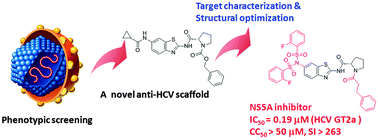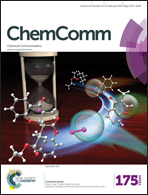The discovery and characterization of a novel scaffold as a potent hepatitis C virus inhibitor†
Abstract
HCV infections are a major global health concern. Although direct acting antiviral agents have significantly improved the response rate of anti-HCV therapy, they also suffer from drug resistance, unfavorable pharmacokinetic profiles and high costs. Thus, it is still highly desirable to develop new anti-HCV therapeutics. Herein a novel anti-HCV benzothiazole scaffold was discovered by phenotypic screening. Further target characterization and structural optimization studies revealed that the benzothiazole-disulfoamide derivatives were potent anti-HCV molecules with good selectivity and acted by targeting NS5A.


 Please wait while we load your content...
Please wait while we load your content...